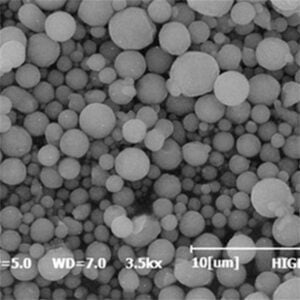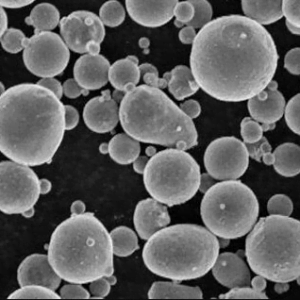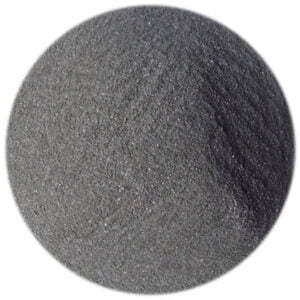Poudre métallique pour l'impression 3D
Table des matières
Vue d'ensemble Poudre métallique pour l'impression 3D
Les poudres métalliques d'impression 3D sont de fines poudres métalliques utilisées comme matières premières dans divers processus de fabrication additive de métaux pour fabriquer des pièces et des produits métalliques. Les poudres métalliques les plus courantes utilisées pour l'impression 3D sont l'acier inoxydable, le titane, les alliages de nickel, l'aluminium et le cobalt-chrome.
La fusion sur lit de poudre métallique et le dépôt par énergie dirigée sont les deux principales familles de procédés d'impression 3D de métaux qui utilisent des poudres métalliques pour construire des pièces couche par couche à partir de modèles de CAO. Les caractéristiques et les propriétés des poudres métalliques ont un impact significatif sur la qualité, la précision, l'état de surface et les performances de la pièce finale.
Détails clés :
- Poudres métalliques courantes : acier inoxydable, titane, alliages de nickel, aluminium, cobalt-chrome
- Principaux procédés d'impression 3D de métaux : Fusion sur lit de poudre, dépôt par énergie dirigée
- Les caractéristiques des poudres sont essentielles pour la qualité des pièces
- Gamme d'options d'alliage en fonction de l'application
- Le plus largement utilisé pour le prototypage et la production dans tous les secteurs d'activité
- Offre des avantages tels que les géométries complexes, l'allègement, la consolidation des pièces.

Types de poudres métalliques et compositions
Il existe de nombreuses poudres d'alliages métalliques standard et personnalisées disponibles pour l'impression 3D auprès de divers fabricants de matériaux. La plupart des alliages sont optimisés spécifiquement pour les processus de fabrication additive.
| Métal | Alliages courants | Composition typique |
|---|---|---|
| Acier inoxydable | 316L, 17-4PH, 304L, 420 | Fe, Cr, Ni, Mo |
| Titane | Ti-6Al-4V, Ti 6242 | Ti, Al, V, Sn |
| Aluminium | AlSi10Mg, AlSi7Mg | Al, Si, Mg |
| Alliages de nickel | Inconel 718, Inconel 625 | Ni, Cr, Fe, Nb, Mo |
| Chrome cobalt | CoCrMo, CoCrW | Co, Cr, W, Si, Mn |
Acier inoxydable 316L et Ti-6Al-4V sont les alliages les plus utilisés actuellement pour l'impression 3D de métaux. De nouveaux alliages aux propriétés améliorées sont continuellement développés et introduits pour des applications exigeantes dans les domaines de l'aérospatiale, de la médecine, de l'automobile et de l'ingénierie générale.
Propriétés des poudres d'impression sur métal
Les principales propriétés des poudres métalliques qui déterminent la qualité des pièces et la stabilité des processus sont les suivantes :
Taille des particules - Entre 15 et 45 microns
Morphologie - Sphéroïdale, bonne fluidité
Chimie - Composition de l'alliage dans des tolérances étroites
Densité - Densité apparente et densité de piquage : des indicateurs clés
Débit - Essentiel pour l'uniformité de l'épaisseur de la couche
Réutilisabilité - Recyclage jusqu'à 5-10 fois en général
| Propriété | Fourchette recommandée | Importance |
|---|---|---|
| Taille des particules | 15 - 45 microns | Affecte l'écoulement de la poudre, l'étalement et la résolution. |
| Forme des particules | Sphérique | Permet un bon écoulement et une bonne densité d'emballage |
| Composition chimique | Alliage spécifique | Détermination des propriétés mécaniques |
| Densité apparente | Plus de 50% de densité de matériau | Indique l'efficacité de l'emballage |
| Densité du robinet | Au-dessus de 80% de densité de matériaux | Indique la fluidité et l'aptitude à l'étalement |
| Débit | 25 - 35 secondes pour 50 g | Essentiel pour des couches uniformes |
| Cycles de réutilisation | Jusqu'à 10x | Réduction des déchets de matériaux |
Distribution de la taille des particules est particulièrement critique dans la plage de taille optimale - trop de fines ou de grosses particules en dehors de la fraction idéale provoquent des défauts. Les fabricants visent un rendement élevé dans le cadre d'une spécification étroite et une qualité constante des lots.
Applications des poudres d'impression 3D de métaux
L'impression 3D de pièces métalliques gagne du terrain dans les secteurs de l'aérospatiale, des appareils médicaux, de l'automobile et de l'ingénierie générale.
Voici quelques applications typiques des matériaux courants :
Acier inoxydable - Équipement de manutention des aliments, outils chirurgicaux, tuyaux, boîtiers de pompes
Titane - Pièces de structure d'aéronefs et de giravions, implants biomédicaux
Aluminium - Composants automobiles, échangeurs de chaleur, articles de sport
Superalliages de nickel - Aubes de turbines, pièces de moteurs de fusées, applications nucléaires
Chrome cobalt - Remplacement du genou ou de la hanche, couronnes et bridges dentaires
La fabrication additive de métaux permet d'obtenir des produits plus légers, plus résistants et plus performants. Elle est rentable pour les matériaux coûteux utilisés en faibles volumes avec des géométries personnalisées, comme les composants aérospatiaux. L'impression 3D simplifie aussi grandement la fabrication de modèles complexes avec des canaux internes pour un refroidissement conforme dans les moules d'injection.
Spécifications pour les poudres métalliques
Des normes internationales et industrielles ont été établies pour garantir le respect des exigences de qualité lors de la production industrielle de poudres métalliques AM :
| Standard | Description | Spécifications |
|---|---|---|
| ASTM F3049 | Guide standard pour la caractérisation des poudres métalliques | Chimie, distribution des tailles, forme, débit |
| ASTM F3301 | Spécification pour la fabrication additive de poudre d'acier | Composition, taille, morphologie, défauts |
| ASTM F3318 | Spécification pour la fabrication additive de poudre de Ti | Taille des particules, chimie, densité de remplissage, réutilisation |
| ISO/ASTM 52900 | Principes généraux pour l'AM des poudres métalliques | Méthodes de production des poudres, procédures d'essai |
| ASME PPC-2019 | Société américaine des ingénieurs en mécanique | Lignes directrices sur la qualité des poudres |
Les fabricants fournissent des certificats de lots de poudre avec les résultats des tests démontrant la conformité aux normes pour les matériaux les plus courants tels que 316L ou Ti64.
Fabrication de poudres métalliques Fournisseurs et coûts
Une large gamme de poudres métalliques pour la fabrication additive est disponible à la fois auprès de grands conglomérats et de plus petits producteurs spécialisés dans le monde entier. Parmi les principaux fournisseurs, on peut citer
Fabricants de poudres métalliques
| Entreprise | Siège | Matériaux |
|---|---|---|
| Charpentier | ÉTATS-UNIS | Acier à outils, acier inoxydable, superalliages |
| Hoganas | Suède | Aciers inoxydables, alliages |
| AP&C | Canada | Titane, Inconel |
| Sandvik | Suède | Acier inoxydable, acier à outils, chrome cobalt |
| Praxair | ÉTATS-UNIS | Titane, métaux réactifs |
| LPW | ROYAUME-UNI | Acier inoxydable, aluminium, Inconel |
| EOS | Allemagne | Acier à outils, acier inoxydable, titane |
Coûts des poudres métalliques
| Matériau | Coût par kg |
|---|---|
| Titane Ti64 | $150 – $500 |
| Aluminium AlSi10Mg | $90 – $150 |
| Acier inoxydable 316L | $40 – $120 |
| Inconel 718 | $180 – $300 |
| Chrome cobalt | $250 – $500 |
Le coût dépend de l'alliage, de la norme de qualité, du fabricant, du volume d'achat, de la région, etc. Les alliages personnalisés peuvent coûter plusieurs fois plus cher que les qualités standard. Les alliages personnalisés peuvent coûter plusieurs fois plus cher que les qualités standard. La poudre est le principal facteur contribuant aux coûts de fabrication de l'AM, c'est pourquoi les utilisateurs cherchent à la réutiliser autant que possible.
Comparaison des procédés d'impression 3D de métaux
Il existe deux grandes familles de techniques de fabrication additive adaptées aux matériaux métalliques. Fusion en lit de poudre (PBF) et Dépôt d'énergie dirigée (DED). Il existe différentes méthodes avec des variations mineures en fonction de la source de chaleur utilisée pour la fusion localisée des couches de poudre métallique.
Méthodes de fusion sur lit de poudre:
- Fusion sélective par laser (SLM)
- Frittage sélectif par laser (SLS)
- Fusion par faisceau d'électrons (EBM)
Méthodes de dépôt d'énergie dirigée:
- Dépôt de métal par laser (LMD)
- Façonnage des filets au laser (LENS)
Comparaison des méthodes d'impression 3D de métaux
| Paramètres | Fusion de lits de poudre | Dépôt d'énergie dirigée |
|---|---|---|
| Source de chaleur | Laser ou faisceau d'électrons | Laser ou arc |
| Dépôt | Couches entières | Bassins de fusion ciblés |
| Matériaux | Limité, force moyenne | Très large gamme |
| Résolution | Supérieure <100 μm | Inférieur ~500 μm |
| Finition de la surface | Plus lisse | Relativement rude |
| Taille du bâtiment | Plus petit < 1 m^3 | Plus grande > 1 m^3 |
| Productivité | Plus lent, un seul point laser | Des zones de fusion plus rapides et plus étendues |
Le DED est mieux adapté aux grandes pièces métalliques telles que les moules de réparation ou les carters de turbine, pour lesquelles la précision dimensionnelle n'est pas trop critique. Le procédé PBF offre un état de surface et une résolution nettement meilleurs pour les petites pièces comportant des détails complexes tels que des treillis. Les options de matériaux pour le DED sont plus étendues, y compris les alliages réactifs.
Les deux procédés tirent parti des principaux avantages de l'AM métallique, tels que la personnalisation, la consolidation des pièces et la légèreté des structures. Pour la production, la fabrication hybride combinant l'impression 3D métallique et l'usinage CNC offre un équilibre optimal entre la complexité géométrique et la précision.
Avantages de la fabrication additive métallique
L'utilisation de l'impression 3D pour la production de composants métalliques offre de nombreux avantages techniques et économiques, ce qui favorise l'adoption de cette technologie dans tous les secteurs d'activité :
Avantages de l'AM des métaux
- Liberté de conception pour les formes organiques complexes grâce à l'optimisation de la topologie
- Réduction significative du poids grâce aux treillis et aux parois minces
- Réduction du nombre de pièces par la consolidation des assemblages
- Géométries personnalisées adaptées aux charges et aux fonctions
- Pas d'outillage, pas de fixation et des changements rapides, idéal pour les faibles volumes.
- Réduction des déchets de matériaux par rapport aux techniques soustractives
Des supports en titane forgé plus légers pour les avions, des implants crâniens adaptés aux patients et des buses de carburant simplifiées pour les moteurs sont autant d'exemples où l'AM des métaux apporte une valeur ajoutée par rapport aux approches de fabrication conventionnelles.
Limites de la fabrication additive métallique
Malgré ses avantages, l'additif métallique présente certaines contraintes inhérentes au processus qui empêchent actuellement son utilisation pour de nombreuses applications :
Limites de l'AM des métaux
- Coûts élevés des équipements et des matériaux
- Choix contraint des alliages et des propriétés mécaniques
- Débit inférieur par rapport aux méthodes de production de masse
- Le post-traitement, comme l'enlèvement des supports et le traitement de surface, prend du temps.
- Exigences en matière de qualification et de certification dans les secteurs réglementés
- Imprécisions dimensionnelles et répétabilité réduite
- Rugosité de surface plus importante nécessitant une finition
- Contraintes résiduelles se développant pendant la construction
En raison de ces obstacles techniques et économiques, l'AM convient mieux aux petites séries, dont les avantages l'emportent sur les limites. Les techniques soustractives hybrides permettent de résoudre les problèmes liés aux composants de précision. La R&D en cours sur le matériel et les matériaux, axée sur la qualité, la vitesse et l'optimisation des paramètres, améliore la viabilité industrielle.

FAQ
Voici quelques questions courantes relatives aux poudres métalliques utilisées dans les processus d'AM :
Q : Quels sont les alliages métalliques les plus utilisés actuellement pour l'impression 3D ?
A : Acier inoxydable 316L, alliage de titane Ti-6Al-4V, alliage d'aluminium AlSi10Mg, superalliages de nickel Inconel 625 et 718, et alliages de chrome cobalt CoCr.
Q : Quels sont les tests effectués pour garantir la constance de la qualité des lots de poudres d'impression métallique ?
R : Les fournisseurs effectuent des essais conformément aux normes industrielles pour vérifier que la composition chimique est conforme aux tolérances, que la distribution de la taille des particules correspond aux fractions idéales optimisées pour les processus d'AM, que la morphologie et la forme de la poudre sont sphériques, que les densités apparentes et de piquage correspondent à la plage permettant un bon écoulement, et que le débit est approprié.
Q : La poudre métallique vierge est-elle obligatoire ou peut-on également utiliser de la poudre recyclée ?
R : Il est possible d'utiliser à la fois de la poudre vierge et de la poudre recyclée provenant de constructions antérieures, en fonction des applications, généralement jusqu'à 5 à 10 cycles de réutilisation avant de rafraîchir avec de la poudre vierge.
Q : Comment les poudres métalliques destinées à l'AM sont-elles produites ?
R : Les techniques de fabrication courantes comprennent l'atomisation par gaz, l'atomisation par plasma et les procédés électrolytiques. Elles permettent d'obtenir des poudres sphériques fines qui conviennent à l'étalement des couches minces et uniformes requises dans le PBF métallique.
Q : Quelles sont les causes des défauts liés aux poudres dans les pièces métalliques imprimées en 3D ?
R : Contaminants dans les poudres, trop de satellites ou de particules irrégulières en dehors des spécifications de taille, problèmes de dégradation des poudres au cours des cycles de réutilisation, et problèmes d'épaisseur ou d'uniformité de la couche lors de l'épandage et du recouvrement.
Q : Comment les acheteurs peuvent-ils sélectionner et se procurer le type et la qualité de poudre métallique optimale ?
R : Les fabricants réputés qui fournissent des fiches techniques complètes sur les matériaux, des certificats d'analyse pour les lots de production, la conformité aux normes industrielles telles que la norme ASTM F3049, la preuve de données d'essais de contrôle de qualité rigoureux et des garanties concernant la chimie, la distribution de la taille, les rendements, etc.
Conclusion
En résumé, les poudres métalliques sphériques fines aux caractéristiques étroitement contrôlées jouent un rôle essentiel en tant que matière première de base pour la fabrication additive de composants métalliques de précision dans les domaines de l'aérospatiale, de la médecine, de l'automobile et de l'ingénierie.
L'acier inoxydable, le titane, l'aluminium, les superalliages de nickel et le chrome-cobalt sont les matériaux les plus utilisés actuellement dans les applications de production industrielle. La qualité et la précision des pièces, les propriétés des matériaux et la stabilité des processus dépendent fortement de la taille, de la forme, de la chimie, de la densité et des paramètres d'écoulement des poudres.
À mesure que la qualité et le choix des alliages augmentent et que la productivité des équipements s'accroît, l'impression 3D semble sur le point de transformer la fabrication dans de multiples secteurs en permettant de fabriquer des produits plus légers, plus résistants et plus performants grâce à des conceptions jusqu'alors impossibles pour des pièces optimisées sur le plan topologique et consolidées à partir d'assemblages.
Partager sur
MET3DP Technology Co. est un fournisseur de premier plan de solutions de fabrication additive dont le siège se trouve à Qingdao, en Chine. Notre société est spécialisée dans les équipements d'impression 3D et les poudres métalliques de haute performance pour les applications industrielles.
Articles connexes

Supports imprimés en 3D pour les capteurs radar automobiles : Précision et performance
Lire la suite "À propos de Met3DP
Mise à jour récente
Notre produit
CONTACTEZ-NOUS
Vous avez des questions ? Envoyez-nous un message dès maintenant ! Nous répondrons à votre demande avec toute une équipe dès réception de votre message.
Obtenir les informations de Metal3DP
Brochure du produit
Obtenir les derniers produits et la liste des prix

Poudres métalliques pour l'impression 3D et la fabrication additive
PRODUIT
cONTACT INFO
- Ville de Qingdao, Shandong, Chine
- [email protected]
- [email protected]
- +86 19116340731
















